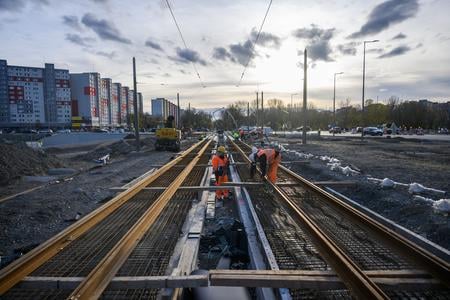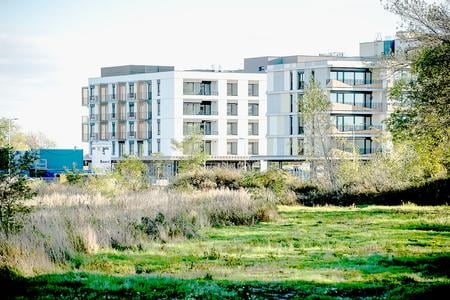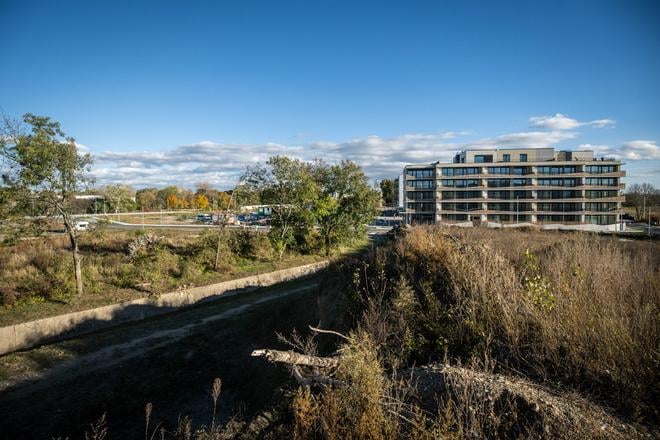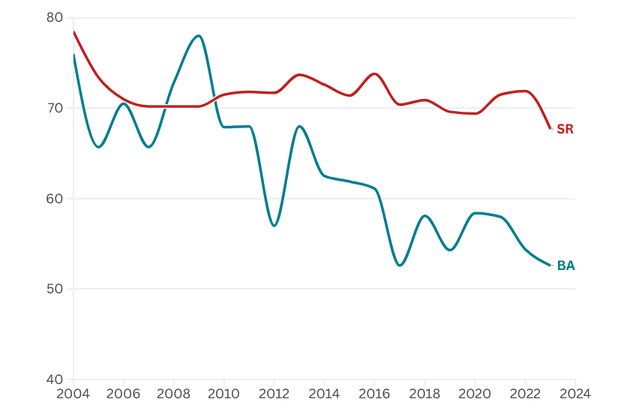New flats in Bratislava have been getting smaller in recent years, as evidenced by data and the experience of real estate agencies and developers.
Behind the decreasing area is mainly the effort of developers to keep customers interested in new buildings despite rising prices.
The average flat in new buildings was around 76 square metres 20 years ago; today, it is only around 52.
"The average area of a flat in the JTRE projects depends on a given segment, but in our case it's also true that it has decreased by roughly 10 percent in 10 years," said JTRE spokesperson Daniel Suchý.
"According to statistics, the purchasing power of the Slovak population has hardly changed since 2012. However, the costs of housing construction have changed, significantly that is," says Slovak Chamber of Architects chair Nora Vranová.
"The price of one square metre reflects the increasing prices of construction materials and energy, the cost of labour, the more advanced technological equipment of households, the lack of suitable land for construction, especially in Bratislava, but also the lengthy permit process," she explained.
For their money, the average buyer can afford an increasingly smaller area, so the market responds with smaller flats.
It can be expected that this trend will continue, but the shrinking of flats has its limits.
"People who buy flats to live in are more sensitive to this than real estate investors," said Vladimír Kubrický, an analyst at the Real Estate Union of the Slovak Republic.

Pressure on lower price
Evidence shows that the total area of newly built flats in Bratislava is decreasing, especially after 2013, according to this graph based on Statistics Office data. The decrease in area is not as noticeable across Slovakia.
Bencont Investment's data on how new buildings sell demonstrate that the number of rooms in flats has hardly changed in the last 10 years, so this cannot be simply explained by the fact that more one- or two-room flats are being constructed in the capital compared to the past. Developers are just building smaller flats area-wise.
"With the increase in construction costs and the difficulty of obtaining financing, the pressure on the buyer is also growing, who will save on the final price due to reduced area," explains Daniel Suchý from JTRE.
According to JTRE data, the average flat in Bratislava's new buildings was around 72 square metres 10 years ago; today, it is around 65 square metres. Developers have noticed the change in what customers prefer, which is also reflected in the layouts and sizes of flats.
"However, we still offer larger, more spacious three- or four-room flats for families in our projects," says Suchý.
Another developer, Corwin, offers one- to four-room flats, with the specific ratio of different types of flats in different buildings fluctuating.
"In addition to the economic aspects, demographic developments also play a role – there are more individuals who live alone and prefer their own housing to renting one," says Katarína Suchá from RE/MAX. The number of flats with an area of 20 to 35 square metres in new projects is increasing.
"Lower prices may not always be the goal," says Tomáš Augustín, YIT director of development and project management.
"It's a more complex issue, one also related to meeting standards, such as the number of parking spaces, lighting requirements, or the developers' efforts to optimise the housing mix, etc."
Area does not matter
With high prices, customers want every square metre of their new home to be used.
"Surveys also confirm that for many clients the number of rooms is more important than the total area of the flat. They would buy a smaller three-room flat with a separate children's room, for example, rather than a two-room apartment with a similar or slightly smaller area," says Alan Pavúk from Corwin.
A flat with a smaller but efficiently used area can fulfil its role just as well as a similar flat with a slightly larger area, the developers say.
"At the same time, the preferences of clients are also changing, for whom the importance of the rooms in the day part of the flat is growing, and they are satisfied with a smaller night part, especially the bedroom," says Pavúk. According to him, customers do not want to pay for 'dead space'.
Corwin has noticed that clients are asking more often what their monthly housing payments will be, and they place great emphasis on the lowest possible costs. "Of course, they also pay lower real estate tax for a smaller flat," says Pavúk.

A challenge for architects
Slovakia does not have regulation that would determine the minimum area of flats. Even technical standards are more of a recommendation. The current regulation determines, for example, the parameters of a living room, which must not be smaller than eight square metres.
Slovak Chamber of Architects president Nora Vranová assumes that the vast majority of new flats respect the relatively economical requirements.
"But there is a difference between minimum requirements and adequate comfort," says Vranová.
Developers and real estate agencies claim that the demand for quality building materials and good layout solutions is not decreasing. According to them, the quality of housing is changing, but it cannot be clearly said that it is decreasing.
"Among the most common objections is the limited space, which sometimes does not provide sufficient comfort for long-term living," says real estate expert Ján Hámorský from RE/MAX. "Buyers or tenants often criticise the lack of storage space, smaller kitchens or bathrooms."
After 2000, it was normal for architects to design two-room flats with an area of 55 to 60 square metres; today, according to Vranová, two-room flats over 50 square metres are difficult to sell.
"Equipping such a flat effectively is starting to be a challenge even for an architect, but it can be done," she said. "The future will likely bring new challenges for the apartment typology, with an emphasis on the multifunctionality and flexibility of rooms, common areas and services in apartment buildings, and other innovations."
© Sme


 Illustrative image. (source: Jozef Jakubčo)
Illustrative image. (source: Jozef Jakubčo)
 The development of an average area of a new flat in Slovakia (red) compared to Bratislava (blue) over the years. (source: SME)
The development of an average area of a new flat in Slovakia (red) compared to Bratislava (blue) over the years. (source: SME)